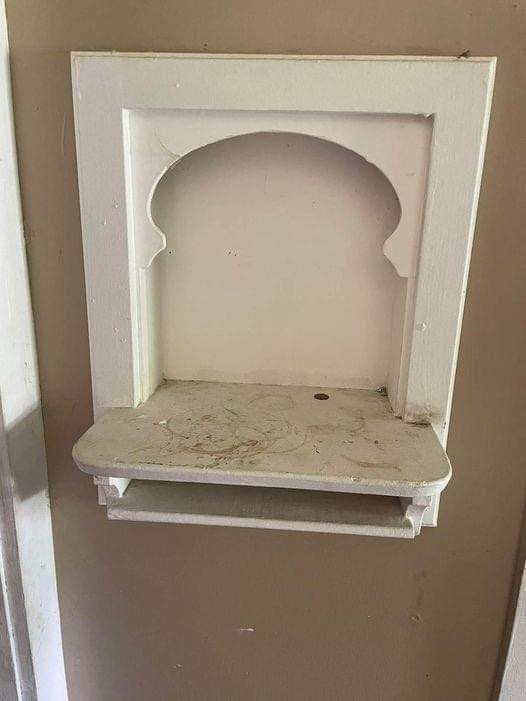If you’ve ever lived in a house built between the early to mid-1900s, you might have noticed a small shelf built into the wall, usually in the kitchen or hallway. At first glance, it might seem like a quirky design choice with no clear purpose. However, there was actually a practical reason for this little nook. So, what was this shelf originally used for, and why was it positioned lower on the wall? Let’s explore its origins and potential for modern use.

Understanding the Phone Alcove
The small wall shelf in older homes is commonly referred to as a “phone alcove.” During the mid-20th century, long before the era of cellphones, landlines were the primary means of communication. Since most homes had only one phone, it was usually installed in a central location. These built-in alcoves were designed to serve as a dedicated space for the landline, making it accessible to all family members.
Typically located in high-traffic areas like the kitchen or hallway, phone alcoves were designed to hold a bulky rotary phone. They also often featured a small drawer or additional shelf space beneath the phone for storing address books, phone directories, or notepads—essential tools for jotting down numbers and messages. Back then, the phone alcove was the communication hub of the household, similar to how smartphones function today.
Why Was It Built Lower?
One of the most notable features of the phone alcove was its lower placement on the wall. Unlike today’s countertops or tables, the phone alcove was positioned lower for a couple of practical reasons:
- Convenient Access The lower height made it easier for people of all ages to use. Children could reach the phone more easily, allowing them to answer calls or place outgoing calls when needed.
- Phone Design Early landline phones were heavy and had shorter cords, so the lower positioning made it easier to handle the receiver while sitting or standing. The design ensured that the phone was stable, reducing the risk of it being dropped or damaged.
- Compact Space Use Older homes often made use of every available inch of space. The phone alcove’s lower position allowed homeowners to have a designated spot for the phone without taking up valuable counter space in the kitchen or hallway.
Repurposing the Phone Alcove Today
Even though landlines have become nearly obsolete, many homes still have these charming phone alcoves. If you’re lucky enough to have one, there’s no need to let it go to waste. There are plenty of creative ways to repurpose this space in your modern home:
- Vintage Decor Embrace nostalgia by placing a vintage rotary phone in the alcove. It adds a touch of retro charm and can serve as a conversation piece, reminding us of the pre-digital era.
- Mini Library If you’re a book lover, consider turning the alcove into a mini bookshelf. It’s a great spot for storing small books, cookbooks, or even a few favorite novels. This setup adds character to the space and makes the alcove functional once again.
- Indoor Garden For those with a green thumb, the alcove can become a mini indoor garden. Place a few small potted plants, like succulents or ferns, to bring a bit of greenery indoors. It’s an easy way to make use of the space while adding a fresh, natural element to your decor.
- Charging Station Bring a modern twist to the old phone alcove by turning it into a charging station. Add an extension cord or power strip, and you’ve got a handy spot for charging smartphones, tablets, or other devices.
- Storage Nook The alcove can also be used as a small storage space for everyday items. Store keys, mail, notepads, or other household essentials. It’s a convenient spot to keep things organized, making it easy to grab items as you head out the door.
Old Home Features: Charm and Character
There’s something special about the unique architectural features found in older homes. While new homes often focus on open floor plans and modern designs, older homes have their own character, highlighted by elements like phone alcoves, built-in ironing boards, or milk doors. These features provide a glimpse into the past, reminding us of how people lived and adapted their homes to fit the needs of the time.
Today, these vintage details offer a mix of nostalgia and opportunity. They’re not just remnants of the past but can be creatively repurposed to add charm to a modern home. While newer homes may offer sleek designs and the latest technology, they often lack the sense of history that comes with living in an older home. It’s the little details, like a phone alcove, that add character and make a house feel truly unique.
My Appreciation for Old Home Details
I’ve always admired the convenience of new homes, with their modern layouts and high-tech features. However, I also have a deep appreciation for the charm found in older homes. Although my house doesn’t have a phone alcove, I’m envious of those who do. There’s a certain charm in imagining how families once gathered around this little nook to make calls or check phone directories.
Conclusion: A Piece of History in Your Home
The phone alcove might seem like a relic from the past, but it holds a special place in the history of home design. While its original purpose may no longer be relevant in the age of smartphones, it can still serve as a functional and decorative feature in modern homes. Whether you use it to display a vintage phone, create a mini garden, or store small items, the phone alcove offers a chance to blend the past with the present.
So, if your home has one of these charming features, embrace it! It’s more than just an old shelf—it’s a piece of history that can add character and creativity to your living space.





